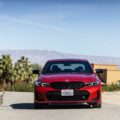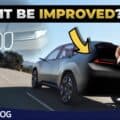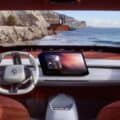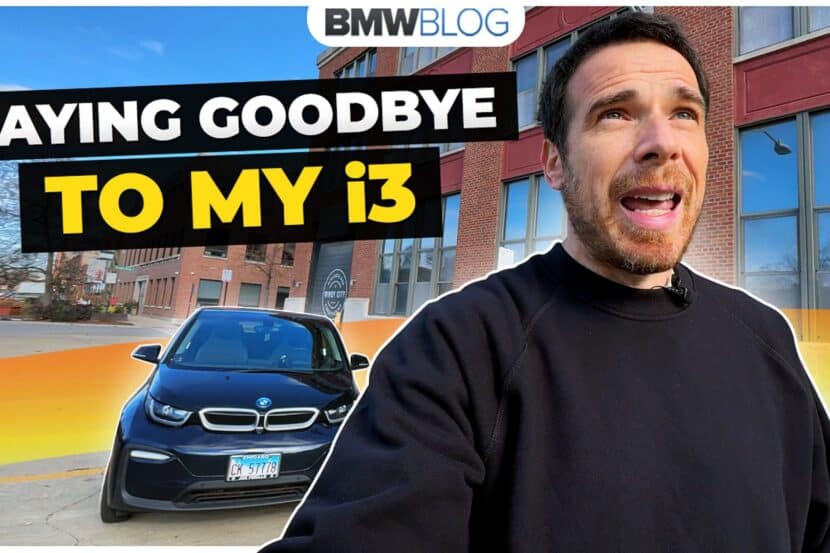After years of development, the new BMW i3 makes its world debut today.
BMW i3 uses a hybrid synchronous electric motor, which weighs only 110 lbs., and has maximum revs of 11,400 rpm, generates an output of 170 hp and outputs maximum torque of 184 lb-ft. That’s propels the 2,700 lb car from 0-30mph in 3.5 seconds, 0-60mph in approximately 7.2 seconds, and to an electronically limited top speed of 93 mph (preliminary USA figures).
The BMW i3 will go on sale in the US market in the second quarter of 2014, and starts with a base MSRP of $41,350, before any federal or state incentives, and before Destination & Handling fee (currently $925).
The new BMW i3 is the first vehicle from Munich to make extensive use of carbon fiber. Its LifeDrive architecture concept, which was purpose-built specifically for the BMW i3, is comprised of two modules; the Life Module, and the Drive Module. Both those modules are made of Carbon Fiber Reinforced Plastic (CFRP).
Carbon Fiber Reinforced Plastic (CFRP) is equally as strong as steel, while being 50% lighter, and 30% lighter than aluminum. Therefore the BMW i3 weighs about 2,700 lbs (preliminary US figures).
The light weight design of the Life Module also lowers the BMW i3’s center of gravity, making it a more engaging and dynamic car to drive.
The Drive Module, which is constructed out of 100% aluminum, consists of the 22-kWh, 450 lb. lithium-ion battery, electric drive train, MacPherson strut and 5-link rear suspension system and structural and crash components. The battery mounted in the rear, close to the drive wheels, gives impressive performance characteristics while also providing better traction.
The interior is made using high quality renewable sources and recycled materials. 25% of the plastics in the interior and 25% of the thermoplastic parts on the exterior are made from either recycled materials or renewable sources.
According to studies carried out as part of BMW’s Project i, involving more than 1,000 participants and conducted over some 12.5 million miles, it was revealed that the average daily distance covered was around 30 miles.
The BMW i3 will be able to travel 80 to 100 miles on a single charge. This can be increased by up to approximately 12% in ECO PRO mode and by the same amount again in ECO PRO+ mode. It is able to recharge in only 3 hours with the use of a 220V Level 2, 32-amp J1772 charger. The SAE DC Combo Fast Charging, which charges the BMW i3 up to 80% in 20 minutes, and 100% in 30, can be had as an option.
In order to reduce range anxiety, a rear-mounted 650cc, 34 hp, two-cylinder, gasoline- powered Range Extender generator is available, which roughly doubles the vehicle’s range. When the battery gets to a certain level, the Range Extender starts and maintains the battery’s current state of charge. The Range Extender never directly drives the vehicle’s wheels. The Range Extender adds roughly 330 lbs. to the vehicle curb weight and has a fuel capacity of 2.4 gallons.
- Pricing (before federal or local incentives) starts at $41,350; $45,200 for Range Extender model. Destination & Handling Fee not included.
- On Sale: Q2 of 2014 in the USA.
- BMW’s 360 Electric electro mobility services.
- BMW i Remote app, which connects with the car.
- BMW Navigation is standard.
- BMW Intelligent Emergency Call (‘eCall”), Anti theft alarm and Rear Parking Distance Control are standard.
Driving
- 170-hp, 184 lb-ft hybrid-synchronous electric motor with max. revs of 11,400 rpm.
- 80-100 mile real-world EV range.
- 22-kWh lithium-ion battery, which weighs 450 lbs.
- 650cc gasoline powered Range Extender optional; holds charge, doesn’t power wheels.
- 0-30mph in 3.5 seconds, 0-60mph in approximately 7.0 seconds (preliminary).
- Top speed of 93 mph, electronically limited to preserve efficiency.
- BMW’s signature, near-perfect 50-50 weight distribution.
- Ultra-tight turning radius (32.3 ft), which is ideal for city driving.
- Macpherson strut front and 5-link rear suspension set up.
- Single Pedal Driving Concept with Brake Energy Regeneration, which feeds power back into battery.
- 3 drive modes: Comfort, ECO PRO and ECO PRO+.
- 3 hour 220 V @32 amps charging time.
- Optional SAE DC Combo Fast Charging allows for 80% charge in 20mins; 100% in 30 mins.
Chassis and Body
- Purpose built construction. World’s first mass-produced CFRP-constructed electric vehicle.
- Built on innovative LifeDrive architecture composed of two parts: Life Module and Drive Module.
- Life Module is essentially the cabin, constructed from Carbon Fiber Reinforced Plastic (CFRP).
- Drive Module is where all of the powertrain components are housed.
- Drive Module is made from 100% aluminum.
- Magnesium cross-member for instrument panel saves 20% weight vs. steel.
- BMW 1 Series external footprint with BMW 3 Series interior space.
- Adaptive Full LED headlights and LED taillights (standard in US market).
- Weighs in at roughly 2,700 lbs.
- No space-consuming transmission tunnel dividing car’s interior.
- Pillar-less design with rear coach doors allow for easy entry and exit to rear seats.
- Driver-oriented super-ergonomic controls.
- Three vehicle Worlds (trim levels): Mega (standard in US), Giga, and Tera.
- Standard 19-inch light alloy wheels with unique 155/70 all-season tires. 20-inch light alloy wheels optional.
- No transmission tunnel and low console allows for Slide-through Experience, which benefits urban driving by the ability to exit from the passenger side.
Sustainability
- Made with sustainable, renewable materials.
- Instrument panel surround and door trim use fibers from Kenaf plant. o Carbon fiber reinforced plastic (CFRP) roof panel is made partially with recycled CFRP from manufacturing process of other components o 25% of plastic used in interior comprised of recycled materials.
- Dashboard wood trim crafted from responsibly-forested eucalyptus.
- CFRP components are sustainably produced in Moses Lake, WA, USA, where the factory uses hydroelectric power.
- The Leipzig, Germany assembly plant uses wind-generated electricity.
- Olive-leaf extract is used to tan interior leather surfaces.


































































































































































